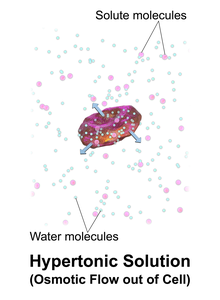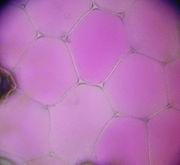165:. Turgor makes plant cells push against each other in the same way and is the main line method of support in non-woody plant tissue. Plant cell walls resist further water entry after a certain point, known as full turgor, which stops plant cells from bursting as animal cells do in the same conditions. This is also the reason that plants stand upright. Without the stiffness of the plant cells the plant would fall under its own weight. Turgor pressure allows plants to stay firm and erect, and plants without turgor pressure (known as flaccid) wilt. A cell will begin to decline in turgor pressure only when there is no air spaces surrounding it and eventually leads to a greater osmotic pressure than that of the cell. Vacuoles play a role in turgor pressure when water leaves the cell due to
198:
32:
84:
73:
185:
285:
Plasmolysis can be of two types, either concave plasmolysis or convex plasmolysis. Convex plasmolysis is always irreversible while concave plasmolysis is usually reversible. During concave plasmolysis, the plasma membrane and the enclosed protoplast partially shrinks from the cell wall due to
286:
half-spherical, inwarding curving pockets forming between the plasma membrane and the cell wall. During convex plasmolysis, the plasma membrane and the enclosed protoplast shrinks completely from the cell wall, with the plasma membrane's ends in a symmetrically, spherically curved pattern.
226:
takes place and the space between the cell wall and cytoplasm is filled with solutes, as most of the water drains away and hence the concentration inside the cell becomes more hypertonic. There are some mechanisms in plants to prevent excess water loss in the same way as excess water gain.
213:
pressure by plasmolysis: pressure decreases to the point where the protoplasm of the cell peels away from the cell wall, leaving gaps between the cell wall and the membrane and making the plant cell shrink and crumple. A continued decrease in pressure eventually leads to
218:– the complete collapse of the cell wall. Plants with cells in this condition wilt. After plasmolysis the gap between the cell wall and the cell membrane in a plant cell is filled with
246:
The liquid content of the cell leaks out due to exosmosis. The cell collapses, and the cell membrane pulls away from the cell wall (in plants). Most animal cells consist of only a
382:
104:
257:
Plasmolysis only occurs in extreme conditions and rarely occurs in nature. It is induced in the laboratory by immersing cells in strong
392:
135:
The term plasmolysis is derived from the Latin word ‘plasma’ meaning ‘matrix’ and the Greek word ‘lysis’, meaning ‘loosening’.
119:
and a net flow of water into the cell. Through observation of plasmolysis and deplasmolysis, it is possible to determine the
416:
411:
282:
Plasmolysis is mainly known as shrinking of cell membrane in hypertonic solution and great pressure.
272:
8:
197:
351:
324:
206:
153:, so that the increased volume of water in the cell will increase pressure, making the
31:
356:
258:
44:
346:
336:
116:
396:
386:
251:
144:
39:
A red blood cell in a hypertonic solution, causing water to move out of the cell.
239:
also keeps water in the plant. The equivalent process in animal cells is called
112:
276:
188:
Plant cell undergoing
Plasmolysis in a Hypertonic solution (x400 magnification)
83:
222:
solution. This is because as the solution surrounding the cell is hypertonic,
405:
247:
124:
360:
323:
Lang, Ingeborg; Sassmann, Stefan; Schmidt, Brigitte; Komis, George (2014).
166:
72:
49:
341:
215:
184:
123:
of the cell's environment as well as the rate solute molecules cross the
275:, which have colored cell sap so that the process is clearly visible.
219:
154:
150:
100:
262:
254:) and not a cell wall, therefore shrinking up under such conditions.
240:
228:
223:
158:
108:
174:
170:
120:
178:
59:
378:
267:
210:
162:
235:
close to help keep water in the plant so it does not dry out.
232:
16:
Process by which cells lose water in a hypertonic solution
236:
322:
149:
A plant cell in hypotonic solution will absorb water by
227:
Plasmolysis can be reversed if the cell is placed in a
403:
209:solution, the plant cell loses water and hence
99:is the process in which cells lose water in a
89:Before plasmolysis (top) and after (bottom)
311:
30:
350:
340:
307:. Australian Society of Plant Scientists.
325:"Plasmolysis: Loss of Turgor and Beyond"
196:
183:
201:Plant cell under different environments
115:solution resulting in a lower external
404:
261:or sugar (sucrose) solutions to cause
302:
169:solutions containing solutes such as
13:
318:
316:
314:
279:can be used to stain plant cells.
14:
428:
371:
111:, can occur if the cell is in a
82:
71:
205:If a plant cell is placed in a
103:solution. The reverse process,
296:
192:
1:
289:
138:
130:
7:
377:Pictures of plasmolysis in
10:
433:
142:
395:October 14, 2007, at the
391:Wilting and plasmolysis.
55:
43:
38:
29:
24:
385:April 16, 2008, at the
161:, a condition known as
202:
189:
342:10.3390/plants3040583
273:onion epidermal cells
200:
187:
303:Munns, Rana (2010).
248:phospholipid bilayer
203:
190:
157:push against the
125:cellular membrane
65:
64:
19:Medical condition
424:
417:Membrane biology
412:Plant physiology
381:and onion skin.
365:
364:
354:
344:
320:
309:
308:
305:Plants in Action
300:
117:osmotic pressure
86:
75:
34:
22:
21:
432:
431:
427:
426:
425:
423:
422:
421:
402:
401:
397:Wayback Machine
387:Wayback Machine
374:
369:
368:
321:
312:
301:
297:
292:
252:plasma membrane
195:
147:
145:Turgor pressure
141:
133:
94:
93:
92:
91:
90:
87:
78:
77:
76:
20:
17:
12:
11:
5:
430:
420:
419:
414:
400:
399:
389:
373:
372:External links
370:
367:
366:
310:
294:
293:
291:
288:
277:Methylene blue
265:, often using
194:
191:
143:Main article:
140:
137:
132:
129:
88:
81:
80:
79:
70:
69:
68:
67:
66:
63:
62:
57:
53:
52:
47:
41:
40:
36:
35:
27:
26:
18:
15:
9:
6:
4:
3:
2:
429:
418:
415:
413:
410:
409:
407:
398:
394:
390:
388:
384:
380:
376:
375:
362:
358:
353:
348:
343:
338:
335:(4): 583–93.
334:
330:
326:
319:
317:
315:
306:
299:
295:
287:
283:
280:
278:
274:
270:
269:
264:
260:
255:
253:
249:
244:
242:
238:
234:
230:
225:
221:
217:
212:
208:
199:
186:
182:
180:
176:
172:
168:
164:
160:
156:
152:
146:
136:
128:
126:
122:
118:
114:
110:
106:
105:deplasmolysis
102:
98:
85:
74:
61:
58:
54:
51:
48:
46:
42:
37:
33:
28:
23:
332:
328:
304:
298:
284:
281:
266:
256:
245:
204:
167:hyperosmotic
148:
134:
96:
95:
50:Cell biology
216:cytorrhysis
193:Plasmolysis
97:Plasmolysis
25:Plasmolysis
406:Categories
290:References
271:plants or
231:solution.
220:hypertonic
207:hypertonic
155:protoplasm
151:endosmosis
101:hypertonic
263:exosmosis
241:crenation
229:hypotonic
224:exosmosis
159:cell wall
139:Turgidity
131:Etymology
113:hypotonic
109:cytolysis
45:Specialty
393:Archived
383:Archived
361:27135521
175:sorbitol
171:mannitol
121:tonicity
352:4844282
233:Stomata
179:sucrose
60:Osmosis
379:Elodea
359:
349:
329:Plants
268:Elodea
259:saline
211:turgor
177:, and
163:turgor
56:Causes
357:PMID
347:PMC
337:doi
243:.
237:Wax
107:or
408::
355:.
345:.
331:.
327:.
313:^
181:.
173:,
127:.
363:.
339::
333:3
250:(
Text is available under the Creative Commons Attribution-ShareAlike License. Additional terms may apply.




